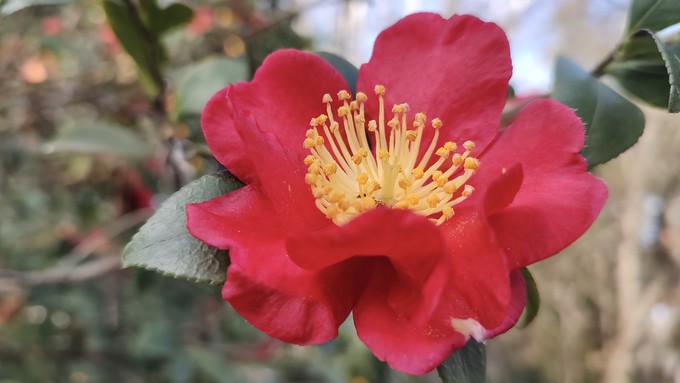
'Yuletide' brightens holidays, feeds hummingbirds with December blooms

'Yuletide' is an appropriate name for this red sasanqua camellia. Debbie Arrington
What’s the perfect flower for Sacramento’s holiday season? My vote goes to the Christmas camellia.
After all, we are the Camellia City and Camellia sasanqua dependably blooms every December – and then some. These camellias also are tough, drought-tolerant and can thrive for decades with little care.
With distinct golden centers, these camellias started opening locally in October. Due to mostly mild weather conditions, they’ve stuck around for more than six weeks and still look good for the holidays.
As a Christmas cut flower, sasanqua camellias are attractive in a vase or bowl. They’re also intensely fragrant and brighten up a room with their scent and color. As a potted plant, they make a thoughtful garden gift.
My three Christmas camellia bushes are at least 40 years old; they were planted when our home was built in 1980 and still going strong. They’re all 'Yuletide,' a variety first introduced by Nuccio’s Nurseries in Altadena in 1963. With distinctive large single red blooms, Yuletide was registered with the American Camellia Society.
My 8-foot Yuletide bushes right now are covered with dozens of big red blooms, each 4 to 5 inches across. The flowers almost glow against their shiny green foliage – a natural holiday combination.
In the early winter garden, Christmas camellias make the greatest impact. Besides looking fantastic, they support beneficial wildlife. Those pretty flowers feed bees and hummingbirds when few other flowers are available. This month, I’ve enjoyed watching the hummers feast on my Yuletides.
Sasanqua camellias bloom two to three months before their close cousins, japonica camellias, which start appearing in February. With natural hardiness, Christmas camellias can thrive in spots where japonicas struggle. They can tolerate drought conditions and colder temperatures. Although they prefer filtered shade or dappled sunlight, Christmas camellias also can take more full sun than japonicas.
Cold, hard rain will bring an end to Christmas camellia season, usually in early January. That’s when they’ll start dropping their flowers in bunches. Pick up and dispose of those fallen flowers to help prevent petal blight, a fungal disease that turns camellia petals prematurely brown. Otherwise, those spores will hang around and infect the japonica camellias as they open.
As landscape plants, Christmas camellias are long-lived (often several decades) and easy care. After flowering, they need little if any pruning; just remove dead wood and gently shape if necessary.
Then, feed sasanqua bushes with an acid-type fertilizer formulated for camellias, which prefer slightly acid soils.
But don’t feed your japonica camellias until after they finish blooming in March. Feeding while camellias are in bloom (or about to bloom) may cause them to drop unopened buds.
Thinking about a gift plant? Christmas camellias can be found in bloom now in local nurseries. These bushes can be transplanted after they finish bloom and will continue to bring smiles for many years to come.
For more about growing camellias locally: https://www.camelliasocietyofsacramento.org/
More on camellias:
Comments
0 comments have been posted.Sacramento Digs Gardening to your inbox.
Food in My Back Yard Series
May 6: Maintain soil moisture with mulch for garden success
April 29: What's (already) wrong with my tomato plants?
April 22: Should you stock up on fertilizer? (Yes!)
April 15: Grow culinary herbs in containers
April 8: When to plant summer vegetables
April 1: Don't be fooled by these garden myths
March 25: Fertilizer tips: How to 'feed' your vegetables for healthy growth
March 18: Time to give vegetable seedlings some more space
March 11: Ways to win the fight against weeds
March 4: Potatoes from the garden
Feb. 25: Plant a fruit tree now -- for later
Feb. 18: How to squeeze more food into less space
Feb. 11: When to plant? Consider staggering your transplants
Feb. 4: Starting in seed starting
Sites We Like
Garden Checklist for week of May 11
Make the most of the lower temperatures early in the week. We’ll be back in the 80s by Thursday.
* Plant, plant, plant! It’s prime planting season in the Sacramento area. Time to set out those tomato transplants along with peppers and eggplants. Pinch off any flowers on new transplants to make them concentrate on establishing roots instead of setting premature fruit.
* Direct-seed melons, cucumbers, summer squash, corn, radishes, pumpkins and annual herbs such as basil.
* Harvest cabbage, lettuce, peas and green onions.
* In the flower garden, direct-seed sunflowers, cosmos, salvia, zinnias, marigolds, celosia and asters. (You also can transplant seedlings for many of the same flowers.)
* Plant dahlia tubers.
* Transplant petunias, marigolds and perennial flowers such as astilbe, columbine, coneflowers, coreopsis, dahlias, rudbeckia and verbena.
* Keep an eye out for slugs, snails, earwigs and aphids that want to dine on tender new growth.
* Feed summer bloomers with a balanced fertilizer.
* For continued bloom, cut off spent flowers on roses as well as other flowering plants.
* Add mulch to the garden to maintain moisture. Mulch also cuts down on weeds. But don’t let it mound around the stems or trunks of trees or shrubs. Leave about a 6-inch-to-1-foot circle to avoid crown rot or other problems.
* Remember to weed! Pull those nasties before they set seed.
* Water early in the day and keep seedlings evenly moist.